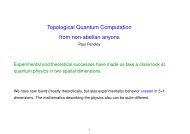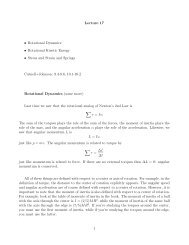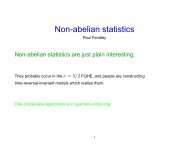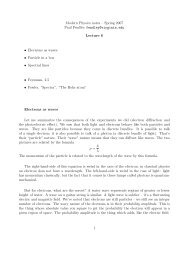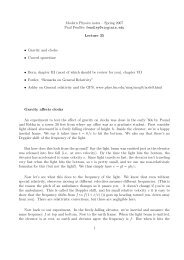Modern Physics notes Paul Fendley fendley@virginia.edu Lecture 6 ...
Modern Physics notes Paul Fendley fendley@virginia.edu Lecture 6 ...
Modern Physics notes Paul Fendley fendley@virginia.edu Lecture 6 ...
Create successful ePaper yourself
Turn your PDF publications into a flip-book with our unique Google optimized e-Paper software.
do it this way, by the way.) So you have to take a plausibility argument the way it is intended:<br />
to give you a short-cut to the right answer. As long as you don’t take it too seriously (i.e. get<br />
upset if it ends up giving the wrong answer), it’s a useful thing.<br />
In this case we know the hand-waving argument is essentially correct because we know how<br />
to do the computations correctly, and will explain this later in the course. Trouble starts in<br />
research when people don’t know the correct answer, but write papers anyway containing only<br />
the hand-waving argument! Then you get to have fun yelling at your colleagues whose handwaving<br />
arguments give a different answer than yours. You then all go to conferences in nice<br />
parts of the world to continue the arguments, so we all win.<br />
Spectral lines<br />
The existence of photons was our first reason for the word “quantum” in quantum mechanics.<br />
Light at a given frequency occurs in discrete lumps, “quanta”. These lumps can be seen easily<br />
experimentally, although not quite by the naked eye (although your eye apparently would need<br />
to be only about 10 times more sensitive to be able to see individual photons).<br />
A second interesting thing also is apparent in the photoelectric effect experiment we did.<br />
You’ll notice something about the light which was coming from the mercury vapor. Instead<br />
of just giving out light of all colors, there were noticeable lines of distinct frequency (you can<br />
check experimentally that these are of distinct frequency, and measure the wavelength, by doing<br />
interference experiments). Since we now know that light frequency is proportional to photon<br />
energy, this tell us that the mercury atoms are not emitting energy of arbitrary sizes. Instead,<br />
the energy seems to be coming out in chunks. Thus again, where classically you might expect<br />
something continuous, here you get something quantized.<br />
Since the entire subject is named “quantum mechanics”, obviously the word quantum is<br />
rather important. To give a first shot at understanding quanta, let’s first understand one way<br />
the wavelength of light can be quantized classically. Say we put light into a box of length L, so<br />
that the light cannot get out. This is called a standing wave: you can think of it as the light<br />
just bouncing back and forth off of mirrors.<br />
Let’s just do a one-dimensional box. The spatial dependence of light of a given wavelength<br />
λ is either<br />
e −2πix/λ or e +2πix/λ<br />
Remember, we can always add two solutions of Maxwell’s equations in a vacuum and get another,<br />
so we can add these two together with arbitrary coefficients ⃗ A and ⃗ B. In a equation:<br />
⃗E = ⃗ Ae −2πix/λ + ⃗ Be +2πix/λ<br />
4




